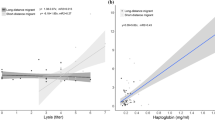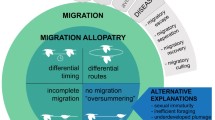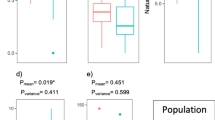Abstract
Migratory birds are exposed to at least two different parasite faunas during their annual cycle, while resident birds only experience a single parasite fauna. Migratory birds should therefore have evolved mechanisms to control or reduce the negative impact of infections from a more diverse parasite fauna. In a comparison of pairs of closely related species of birds that differ with respect to whether they are migratory or residents, the size of two immune defence organs (the bursa of Fabricius and the spleen) was consistently larger in the migratory species. Since the bursa is only found in juvenile, sexually immature birds, we conclude that immune defence adaptations to the impact of a more diverse parasite fauna in migrants already exist before the start of the first migration. Interspecific differences in investment in immune defence between migratory and resident birds have implications for our understanding of complex host–parasite interactions, the acquisition of new hosts by parasites, and the susceptibility of migratory birds to environmental perturbations.
Similar content being viewed by others
References
Alberts, B., Lewis, J., Ratt, J.M., Roberts, K. and Watson, J.D. (eds) (1983) The immune system. In Molecular Biology of the Cell, pp. 951–1012. Garland, New York.
Alerstam, T. (1991) Bird Migration. Cambridge University Press, Cambridge.
Alerstam, T. and Enckell, P.H. (1979). Unpredictable habitats and evolution of bird migration. Oikos 33, 228–232.
Alerstam, T. and Högstedt, G. (1982) Bird migration and reproduction in relation to habitats for survival and breeding. Ornis Scand. 13, 25–37.
Arvy, L. (1965) Splènologie. Gauthiers-Villars, Paris.
Askins, R.A., Lynch, J.F. and Greenberg, R. (1990) Population declines in migratory birds in eastern North America. Curr. Ornithol. 7, 1–57.
Becker, W.A. (1984) Manual of Quantitative Genetics. Academic Enterprises, Pullman, WA.
Begon, M., Harper, J.L. and Townsend, C.R. (1986) Ecology: Individuals, Populations and Communities. Blackwell, Oxford.
Bennett, G.M. and Fallis, A.M. (1960) Blood parasites of birds in Algonquin Park, Canada, and a discussion of their transmission. Can. J. Zool. 38, 261–273.
Berthold, P., Fliege, G., Querner, U. and Winkler, H. (1986) Die Bestandsentwicklung von Kleinvö geln in Mittleeuropa: Analyse von Fangzahlen. J. Orn. 127, 397–437.
Chandra, R.K. and Newberne, P.M. (1977) Nutrition, Immunity, and Infection. Plenum Press, New York.
Dogiel, V.A. (1964) General Parasitology. Oliver and Boyd, Edinburgh.
Eichler, W. (1948) Some rules in ectoparasitism. Ann. Mag. Nat. Hist. Ser. 12 1, 588–598.
Ewald, P.W. (1994) Evolution of Infectious Disease. Oxford University Press, Oxford.
Felsenstein, J. (1985) Phylogenies and the comparative method. Am. Nat. 125, 1–15.
Fitzpatrick, S. (1994) Colourful migratory birds: Evidence for a mechanism other than parasite resistance for the maintenance of `good genes' sexual selection. Proc. Roy. Soc. Lond. B 257, 155–160.
Gauthreaux, S.A. (1982) The ecology and evolution of avian migration systems. In Avian Biology, Vol. 6 (D.S. Farner, J.R. King and K.C. Parkes, eds), pp. 93–168. Academic Press, New York.
Gershwin, M.E., Beach, R.S. and Hurley, L.S. (1985) Nutrition and Immunity. Academic Press, Orlando, FL.
Glick, B. (1983) Bursa of Fabricius. In Avian Biology, Vol. 7 (D.S. Farner, J.R. King and K.C. Parkes, eds), pp. 443–500. Academic Press, New York.
Glick, B. (1994) The bursa of Fabricius: The evolution of a discovery. Poultry Sci. 73, 979–983.
Gregory, R.D. (1990) Parasites and host geographic range as illustrated by waterfowl. Funct. Ecol. 4, 645–654.
Greiner, E.C., Bennett, G.F., White, E.M. and Coombs, R.F. (1975) Distribution of the avian haematozoa of North America. Can. J. Zool. 53, 1762–1787.
Hamilton, W.D. and Zuk, M. (1982) Heritable true fitness and bright birds: A role for parasites? Science 218, 384–387.
Harrison, C.A. (1970) A Field Guide to the Nests, Eggs and Nestlings of European Birds. Collins, London.
Harrison, C.A. (1978) A Field Guide to the Nests, Eggs and Nestlings of North American Birds. Collins, Cleveland, OH.
Harvey, P.H. and Pagel, M. (1991) The Comparative Method in Evolutionary Biology. Oxford University Press, Oxford.
James, F.C., McCulloch, C.E. and Wiedenfeld, D.A. (1996) New approaches to the analysis of population trends in land birds. Ecology 77, 13–27.
John, J. (1994) The avian spleen: A neglected organ. Q. Rev. Biol. 69, 327–351.
Keymer, I.F. (1982) Parasitic diseases. In Diseases in Cage and Aviary Birds (M.L. Petrak, ed.), pp. 535–598. Lea & Febiger, Philadelphia, PA.
Marchant, J.H. (1992) Recent trends in breeding populations of some common trans-Saharan migrant birds in northern Europe. Ibis 134 (suppl. 1), 113–119.
Miller, R.A. (1996) The aging immune system: Primer and prospectus. Science 273, 70–74.
Møller, A.P. (1994) Phenotype-dependent arrival time and its consequences in a migratory bird. Behav. Ecol. Sociobiol. 35, 115–122.
Møller, A.P. and Birkhead, T.R. (1992) A pairwise comparative method as illustrated by copulation frequency in birds. Am. Nat. 139, 644–656.
Møller, A.P. and Erritzøe, J. (1996) Parasite virulence and host immune defence: Host immune response is related to nest re-use in birds. Evolution 50, 2066–2072.
Møller, A.P., Dufva, R. and Erritzøe, J. (in press) Host immune defence and sexual selection in birds. J. Evol. Biol.
Molyneux, D.H., Cooper, J.E. and Smith, W.J. (1983) Studies on the pathology of an avian trypanosome (T. bou.ardi) infection in experimentally infected canaries. Parasitology 87, 49–54.
National Geographic Society (1987) Field Guide to the Birds of North America, 2nd edn. National Geographic Society, Washington, DC.
Peterson, R.T., Mountfort, G.R. and Hollom, P.A.D. (1964) The Birds of Europe. Gad, Copenhagen.
Powell, J.A. (1980) Evolution of larval food preference in Microlepidoptera. Ann. Rev. Entomol. 25, 133–159.
Price, P.W. (1980) Evolutionary Biology of Parasites. Princeton University Press, Princeton, NJ.
Price, P.W., Westoby, M. and Rice, B. (1988) Parasite-mediated competition: Some predictions and tests. Am. Nat. 131, 544–555.
Robbins, C.S., Sauer, J.R., Greenberg, R.S. and Droege, S. (1989) Population declines in North American birds that migrate to the neotropics. Proc. Natl. Acad. Sci. USA 86, 7658–7662.
Rose, M.E. (1981) Lymphatic system. In Form and Function in Birds, Vol. 2 (A.S. King and J. McLelland, eds), pp. 341–384. Academic Press, London.
Saino, N., Bolzern, A.M. and Møller, A.P. (1997) Immunocompetence, ornamentation and viability of male barn swallows. Proc. Natl. Acad. Sci. USA 94, 549–552.
Salomonsen, F. (1955) The evolutionary significance of bird migration. Dan. Biol. Medd. 22, 1–62.
Southwood, T.R.E. (1987) Species-time relationships in human parasites. Evol. Ecol. 1, 245–246.
Spencer, K.A. (1990) Host Specialization in the World Agromyzidae (Diptera). Kluwer, Boston, MA.
Terborgh, J.W. (1989) Where Have All the Birds Gone? Princeton University Press, Princeton, NJ.
Toivanen, P. and Toivanen, A. (eds) (1987) Avian Immunology. CRC Press, Boca Raton, FL.
Valkiunas, G. (1991) The role of seasonal migrations in the distribution of Haemosporidia of birds in North Palaearctic. Ekologija 1993, 57–73.
von Haartman, L. (1968) The evolution of resident versus migratory habit in birds: Some considerations. Ornis Fennica 45, 1–7.
Author information
Authors and Affiliations
Rights and permissions
About this article
Cite this article
Møller, A.P., Erritzøe, J. Host immune defence and migration in birds. Evolutionary Ecology 12, 945–953 (1998). https://doi.org/10.1023/A:1006516222343
Issue Date:
DOI: https://doi.org/10.1023/A:1006516222343




